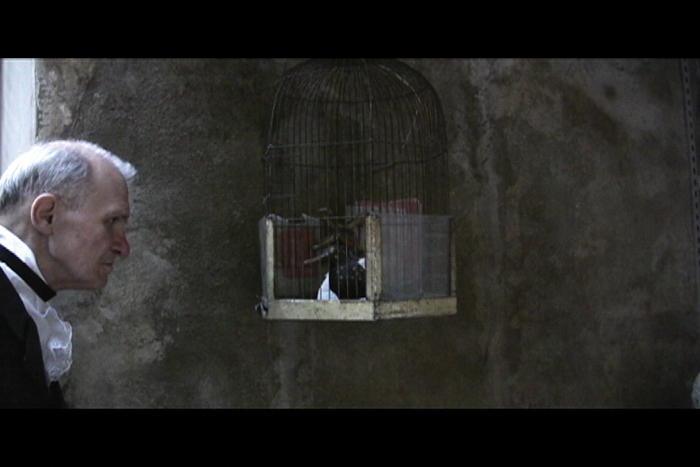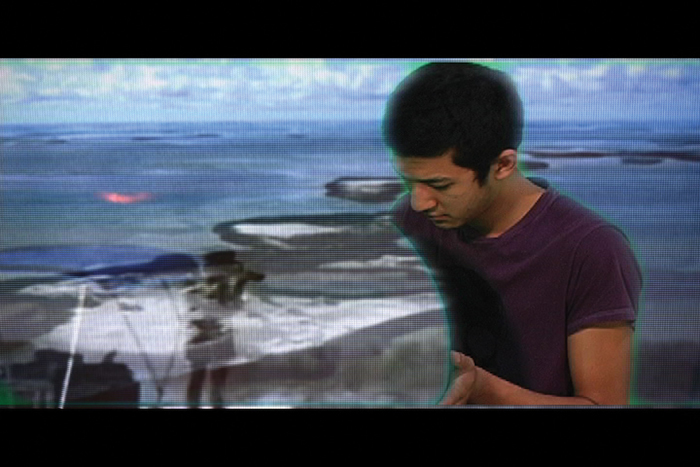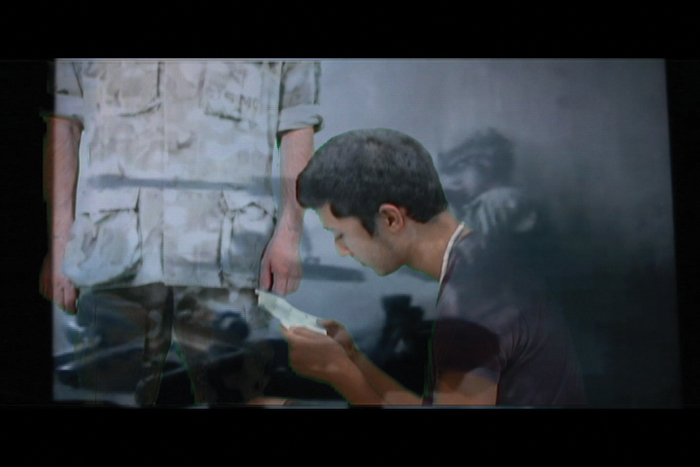I then replaced the boards so cleverly, so cunningly, that no human eye—not even his—could have detected any thing wrong.
–Edgar Allan Poe, “The Tell-Tale Heart,” 1843
Surfaces burying deep dark secrets constitute a common motif in the haunting tales of Edgar Allan Poe. Simon Leung’s POE, a three-channel video installation recently on view at Las Cienegas Projects in Los Angeles,1 refashions the writer’s boards of concealment. The installation utilizes green screens—a primary tool in Hollywood’s arsenal of optical illusions—to link and sequester videos set in Poland, New York, and California, and to contain a treasure trove of art historical and literary remnants, some of them long overlooked gems. The viewer willing to submit to POE’s uncanny logic and to investigate, or to play the modern detective that Poe’s gothic tales helped mold, will unearth a web of tangled narratives from beneath these glowing green veneers.

Simon Leung, POE, 2007/2010. Three-channel video and architectural structure. Courtesy of the artist. Photo: Nicolas O.S. Marques.
POE’s first iteration was as a single channel video created in 2007 at Wave Hill, a public garden and cultural space in the Bronx. This earlier version played on a continuous loop so that that there was no beginning, middle, or end. Each segment—New York,Poland, and Southern California—flowed into the next like an exquisite corpse drawing on infinite rotation. The latest three-channel installation spatially fractures this poetic ramble, physically splintering the narrative and thereby producing a self-consciously, structurally postmodernist artwork.
Each video projection is separated by green screen panels arranged in a crisscross, quasi-looped pattern based on a sketch of a chasm found in Poe’s allegorical novel, The Narrative of Arthur Gordon Pym of Nantucket (1838). This, Poe’s only full-length novel, chronicles Pym’s seafaring adventures, which unravel into accounts of endless geologic chasms bearing blurry resemblances to linguistic signifiers. In his seminal writings of the late 1960s, artist Robert Smithson identifies this novel by Poe and its descriptions of the earth’s chasms as “excellent art criticism and prototype for rigorous ‘non-site’ investigations.”2 Leung appropriates these references, staging scenes from the novel and quoting Smithson’s notes on Pym and the “site/non-site” dialectic, a concept he first encountered through Craig Owens’s influential text of 1980, “The Allegorical Impulse: Toward a Theory of Postmodernism.”3 POE constructs multiple allegories—stories that originate from historical or contemporary occurrences (i.e. Poe’s nineteenth century past and his ongoing legacy), but which readily dissolve into ruminations on a host of subjects spanning space and time (i.e. postwar Poland, gentrification in New York, and Baghdad’s green zone). As such, the artist engages Owens’s model for a critical postmodernism, which in turn becomes yet another of POE’s buried subtexts. Leung uses these writings by Poe, Owens, and Smithson as points of origin, from which springs a vast cartography of ideas, bounded only by the strict geometries of the installation’s green screens.
For Smithson, the earth’s chasms (like those described in Pym)—zones of utter “oceanic” “de-differentiation” and “entropy”—constitute “sites.” He deems his artworks “non-sites,” forms and vocabularies that somehow delineate the limitless “sites.”4 “I have developed the Non-Site, which in a physical way contains the disruption of the site…,” Smithson writes. “It is a three-dimensional perspective that has broken away from the whole, while containing the lack of its own containment. There are no mysteries in these vestiges, no traces of an end or a beginning.”5 POE becomes Leung’s laboratory for testing Smithson’s hypotheses and aims to explore his concepts from within, as a “non-site” itself. But while the earth’s elements and compounds form the raw material for Smithson’s experiments, Leung excavates from the ruins of art and literary history and from the detritus of a deceitful present. Read in this way, POE’s green screens act as a container for the videos’ scattered references and spliced narratives that otherwise spiral out in unbounded directions.

Simon Leung, video still from POE, 2007/2010 (detail). Three-channel video and architectural structure. Courtesy of the artist.
The videos’ presentation, played simultaneously on endless loops, precludes the possibility for any discernable beginning, middle, or end, but POE is, quite fittingly, haunted by mysteries. Viewing the work feels a bit like wandering around backstage at the performance of a play you’ve heard of, but have never seen. Some references you readily get; Edgar Allan Poe’s “The Raven” and “The Tell-Tale Heart,” for instance, show up in dramatizations or in footage from on-screen adaptations. Other references are less obvious, like a body-versus-architecture dance performed by Yvonne Rainer, the great pioneer of minimalist choreography and filmmaking. Then there are elements that remain unsolved puzzles, unless you take the time to connect the dots. This requires surrendering to Leung’s stream of consciousness and following his camera as it meanders down paths opened up through coincidence and free association. POE explores the life, writings and legacy of a nineteenth century American literary figure, Edgar Allan Poe. So why is one video segment shot entirely in Poland? “Because it’s literally Poe-Land,” Leung explains.6 The artist takes his puns seriously, determinedly drawing out their implications.
Throughout the installation, we encounter hints that help us make sense of the work’s at times obscure references. The Smithson quotation, for instance, recurs across segments in what Leung conceptualizes as “transitions.”7 In another “transition,” both the Poland and Southern California videos feature footage of Gregory Poe, a late descendant of the writer. In this scene, Gregory Poe analyzes an antique sword that once belonged to Edgar Allan Poe while recounting the alcoholism that nearly tore his family asunder. These “transitions,” along with static shots of Poe Cottage, in the Bronx, New York, connect each video while also drawing together diverging motifs within videos. The presence of Poe’s old sword, for instance, helps us understand Poland as “Poe-Land,” if we enter that section first. In the Southern California video, the discussion of Poe’s sword opens onto the subject of war as present in a mock green zone. Leung’s repetition of scenes, images, and texts provides clues for the viewer/detective, who might then piece together the work’s multiple narratives out of the broken bits on offer. Of course, the tales here will never fully add up, and the ruptures, shards, and chasms become equally important.

Simon Leung, video still from POE, 2007/2010 (detail). Three-channel video and architectural structure. Courtesy of the artist.
The installation’s central video tells a story, in fragments, of New York University’s purchase and demolition of Poe House, the institution’s promise to resurrect a façade in its place using the house’s original materials, and the creation instead of an off-site, commemorative wall made of all new bricks. This segment features Rainer uneasily fitting her body to the architecture of the Poe House replacement, which here becomes a signifier for the ongoing gentrification of Greenwich Village. We then follow Rainer and others to the Poe Cottage, the writer’s last home in the Bronx, which has been preserved as a museum, although its location has been physically moved. For Leung, the destructed Poe House and the displaced Poe Cottage become points of departure for his reconceptualization of the “site” and “non-site,” as these architectural relics seem to exist somewhere between the two. Furthermore, POE evokes not only theoretical and thematic but also literal connections to Smithson’s writings. In “A Sedimentation of the Mind: Earth Projects,” the primary essay POE references, Smithson quotes Rainer’s stirring statement, “The world disintegrates around me.”8 Leung’s decision to feature Rainer as the work’s central dancer then echoes the presence of her voice in Smithson’s “site/ non-site” formulation. As if in a fissure of crumbling earth, POE freely rolls with the multiplex nuances of its referents.
To the right of the installation’s central video plays the segment set in Warsaw, Poland. The artist depicts the city’s postwar landscape as one characterized by thin architectural artifice, not unlike the simulacral façade of New York’s old Poe House. Warsaw becomes a site for reenacting Poe’s gothic stories, craftily played out in old stone alleyways and cramped, candle-lit interiors by writer and performer Warren Niesluchowski. Here, themes of sinister deception, melancholic isolation, and urban dislocation travel across time and space between present-day New York and nineteenth century Europe. The solitude of Niesluchowski as one of Poe’s tortured characters, epitomized in a meal eaten alone, finds parallel in a moment of forlorn intimacy enacted inside the Poe Cottage by Rainer and New York-based artist, Hong-an Truong. To a voiceover narrating Poe’s horrific account of his wife’s terminal illness, Rainer clings to a perfectly still Truong, who stares off into emptiness. If you look hard enough, these scenes might make you cry. But in POE, you may laugh too: over the absurdity of NYU’s broken promise, or over Rainer’s performative gestures in the Poe Cottage that include her climbing the walls and cocking her face next to a portrait of Poe, which she then pecks away at with a stuffed raven. Absurdity plays a big role in POE, while the absurdity of war lurks in its wings.

Simon Leung, video still from POE, 2007/2010 (detail). Three-channel video and architectural structure. Courtesy of the artist.
A video set in Leung’s own Southern California is positioned across from the Poland one. This segment recounts bits and pieces from The Narrative of Arthur Gordon Pym, loosely interpreted by a cast of the artist’s students. The action takes place in a pool, the ocean, and against various green screen-produced backdrops, including shadowy footage from the sea, the Middle East, and of Smithson’s Spiral Jetty (1970). In Poe’s novel, Pym—an adventure-hungry stowaway who boards a whaling ship bound for the South Seas—finds himself trapped and on the brink of starvation, first in his hiding place in the ship’s hold and later in a deep chasm of the earth. In the video, a struggling wader who is made to repeat lines from Poe’s novel, and who later enters the ocean tied to another young man, alludes to Pym’s precarious passages between freedom and entrapment. Through quotations and contorted movements, the segment delves into the dark recesses of Pym’s journey, which erupts in cannibalism, encounters with hostile natives, and those boundless geologic holes.
Leung links these descriptions to the realities of present-day war in Iraq as the segment unravels into shots of young soldiers engaged in military exercises set against a backdrop of fighter jet bombings and fireworklike explosions. Here, Leung seizes upon Smithson’s observation, “look at any word long enough and you will see it open up into a series of faults,”9 as artistic strategy, allowing the work to travel deep into faults opened up by Smithson’s writings, Poe’s stories, and the United States’ seemingly endless war in the Middle East. The surreal sundrenched landscape of Southern California conjures Baghdad’s green zone, stuck, in naturalized artificiality, somewhere between “site” and “non-site.” Not unlike today’s television viewers, Leung implies, soldiers stationed in the green zone constantly face the imagery of war but remain physically and emotionally distanced through a forcefully imposed social boundary. The project ruminates on the myths of war, as the green zone gives way to the installation’s green screens, those backdrops capable of transporting actors into any number of illusory “non-sites,” falsely transformed into “sites” by modern media.

Simon Leung, video still from POE, 2007/2010 (detail). Three-channel video and architectural structure. Courtesy of the artist.
POE also invites viewers to situate the “non-site” in the installation’s confined, hollow passages that link and separate segments while allowing for intermissions between acts. Each video is roughly twenty minutes in length and plays on a non synchronized loop. Sometimes aural stimuli line up, as when the soldiers tap dancing in Southern California sounds with the typewriter typing in Poland. But Leung leaves the occurrence of such serendipitous moments to chance, as each segment plays alone and at random. While the videos’ accompanying soundtracks—audible but barely comprehensible— consciously overlap in an ode to simultaneity, the architecture of the installation denies any chance of peripheral vision. Each video segment is visually cordoned off from the next, surrounded by green screens from behind and projected out onto the gallery’s walls.
In one extra flourish, all three nooks of the installation include identical decorative benches. Designed by artists Dewey Ambrosino and Brendan Sowersby, the benches evoke theatricality in their black silhouette, fuzzy feel (the effect of a texture spray), and over-the-top deployment of the Arabesque. Perched upon one of these wobbly benches, I am brought back to the idea of POE as stage set for a play never seen. The benches, it turns out, are a sort of private tribute to a little known Poe essay entitled “The Philosophy of Furniture,” which discusses international interior decoration and passionately advocates the Arabesque as a design motif. Such subtle references, like the “Poe-Land” connection, are knowingly tenuous. In the end, or the beginning, or the middle—you’ll never be sure—POE’s power hinges on the fragility of its connections and the green screens’ containment of their limitless permutations.
Jenny Lin is an art historian and writer currently based in Los Angeles.
